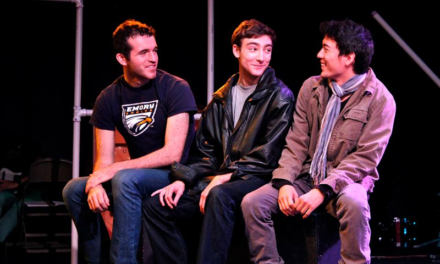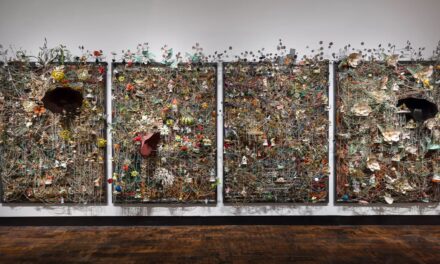What would happen if animals live the world just like humans? “Beastars,” a Japanese animation written by Paru Itagaki, is a story where animals look and behave like real world humans. Similar to Disney’s “Zootopia,” where animals live somewhat peacefully in a civilized society, “Beastars” focuses on the segregation between herbivores and carnivores. While the herbivores are fearful of being attacked and eaten, carnivores struggle between their savage instincts and society’s expectations. Elaborating on ethics and discrimination, “Beastars” successfully illustrates a love story between a wolf and a rabbit, focusing on their respective struggles.
“Beastars” begins on a high school campus where an alpaca, Tem (Takeo Ōtsuka), is killed by an unidentified carnivore. As the killing and eating of herbivores is strictly forbidden in this civilized society, the incident causes significant fear around the campus and introduces the plot’s main conflict between carnivores and herbivores: Who killed Tem? Are carnivores capable of being civilized? This introductory act clearly shows why herbivores do not trust carnivores; for carnivores such as gray wolf Legoshi (Chikahiro Kobayashi), the social expectation goes against their natural instincts.
Despite his strong and intimidating appearance, Legoshi is kind-hearted. He always strays away from trouble despite his strength. However, one night, Legoshi is tempted by a delicious scent that almost leads him to kill rabbit Haru (Sayaka Senbongi). This incident completely changes his world view and, surprisingly, introduces love into his life. This new perspective causes Legoshi to question his place in society, as he is rejected by peer carnivores for his tame personality.
The animation of “Beastars” helps to move the plot and address the struggles of different characters. There are multiple scenes where the audience is able to see each character’s body language, such as finger movements, sweaty faces and teary eyes. During Legoshi’s fight scenes with the tiger Bill (Takaaki Torashima), cinematographer Shinichi Matsumi intentionally sets up a contrast between Legoshi’s dark face and the light on his back, portraying him as a ferocious wolf. Meanwhile, crosscuts of Legoshi punching Bill and scenes of Legoshi hunting Haru down are used to reveal Legoshi’s guilt of hurting Haru. Kobayashi’s skillful voice acting pivots between Legoshi’s normal voice and his mad wolf howls during fight sequences. Through the animation and voice acting, the audience can see how Legoshi is not simply beating Bill; he is also trying to kill the hunting instinct in his mind.
“Beastars” also delves into conflict within the two broad groupings, as herbivores discriminate among themselves — Haru is a dwarf rabbit, the weakest in the group of rabbits, and is constantly being bullied. This is ironic as instead of contributing to a more equal society between carnivores and herbivores, many herbivores bully other herbivores at the same time.
In order to gain some respect and equality, Haru starts to have sex with other male animals, believing that when she is not treated as a despicable dwarf rabbit, but as an equal sex partner in sex. However, Haru’s sexual promiscuity only brings her more condemnation. Though Haru pretends to be strong, the prejudice and discrimination still hurts her deeply, and she cries alone, feeling powerless Haru needs help but, unfortunately, she only receives more slanderous remarks from her peers, as others call her a “slut” and criticize her for her promiscuity without realizing their role in her actions.Watching Haru’s character development also helps audiences reflect on their past experiences. How many times have we intentionally avoided or even criticized people like Haru? How many of us try to approach them and help? Sometimes, a person is not naturally evil. It is the irresponsible criticism and discrimination that pushes them to become a hateful person.
Despite the prevalent prejudice against Haru on campus, Legoshi does not treat her as someone that is despicable, but rather as a normal animal. While, in this case, an intimidating wolf does not take advantage of a weak rabbit, Haru receives more vicious condemnation from our own species. The contradiction between Legoshi and the behaviors of other rabbits demonstrates how a stereotypical identity does not reflect the true personality of a character. By examining Haru’s experience and the hierarchy between animals, “Beastars” actually reflects on our own society. While our focus on reducing broader discrimination is important, there might still be exclusion or discrimination within different minority groups. When individuals from the same ethnicity or with similar backgrounds are excluding each other, how can there be any true equality in the world?
As love gradually develops between Legoshi and Haru later in the animation, Haru also has to suppress natural instincts to serve as prey to predators, and although they want to love each other, their instincts pull them apart. Moreover, social expectations also try to separate them. A wolf is not supposed to marry a rabbit, and vice versa. Both Legoshi and Haru have a lot to conquer in their future endeavors to love each other.
The authority figures in “Beastars” try to promote a peaceful and equal environment by forbidding carnivores from eating, hunting or even showing teeth. However, equality is not only making carnivores eating meat illegal. Equality is also not surprised at a wolf falling in love with a rabbit. It is also about whether any herbivores are brave enough to accept love from a carnivore.






